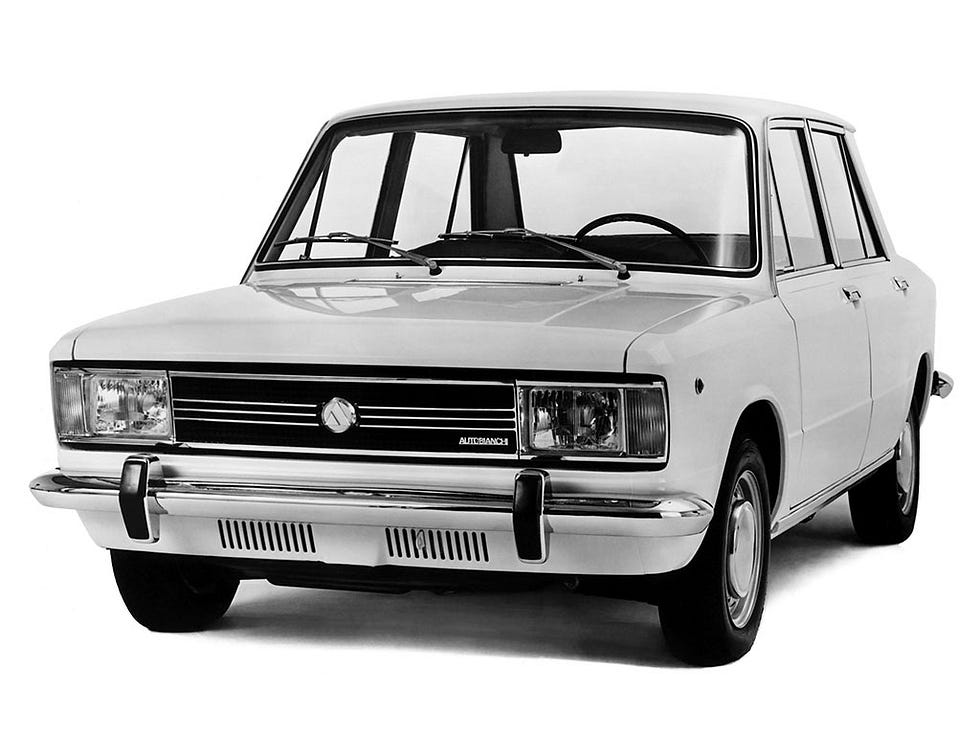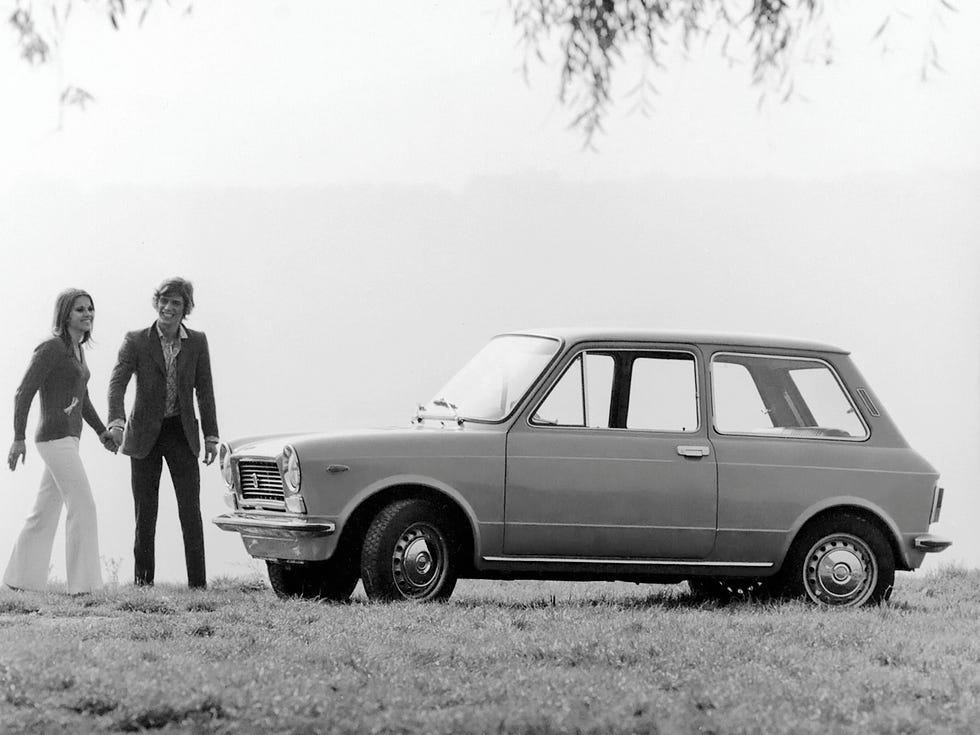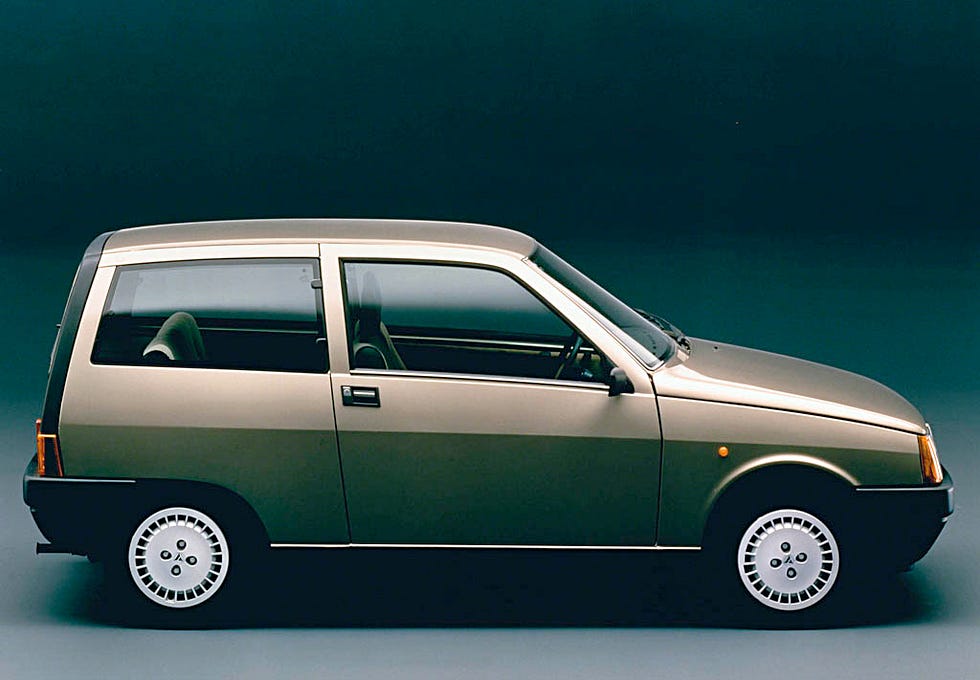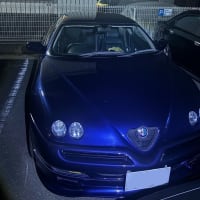A landmark year
1969 was a landmark year in Autobianchi’s history, as it saw the launch of what would turn out to be the brand’s longest-serving and best-selling model, the A112… But also the short-lived and soon forgotten A111.
記念すべき年
1969年はアウトビアンキの歴史にとって画期的な年であり、後にブランドの最長寿ベストセラーモデルとなるA112が発表された年でした。

The Autobianchi A111 (picture from Wheelsage.org)
アウトビアンキA111(画像はWheelsage.orgより引用)
The Autobianchi A111 was an indirect replacement for the Primula, which mated the latter’s suspensions and running gear with a more traditional three-box sedan bodyshell and a particularly well-appointed interior.
However, the A111 received little marketing support and was quietly discontinued in 1972. By then, Fiat’s upper management had decided, following the recent acquisition of Lancia, that Autobianchi’s offerings were to be confined to the lower end of the market.
A111はプリムラの間接的な後継車種であり、プリムラのサスペンションとランニングギアに、より伝統的な3ボックスセダンのボディシェルと特によく整えられたインテリアが組み合わされていた。
しかし、A111はマーケティング的な支援はほとんど受けられず、1972年にひっそりと生産終了となった。その頃、フィアットの上層部は、ランチアの買収に伴い、アウトビアンキの製品は低価格帯の市場に限定することを決定していたのである。
The greatest success
The A112 story began sometime in 1966 as Fiat’s project X1/2. In the intentions of Dante Giacosa, the X1/2 was to replace the outdated rear-engined Fiat 600 and 850.
About 3.2 meters long and equipped with the 850’s engine mounted transversely at the front sending its power to the front wheels, the X1/2 was to finally bring Fiat’s mass-market offerings into the modern era.
最大の成功
A112の物語は、1966年のある日、フィアットのプロジェクトX1/2として始まった。ダンテ・ジャコーザの意向で、X1/2は時代遅れのリアエンジンのフィアット600と850を置き換えるためのものだった。
全長約3.2m、850のエンジンをフロント横置きにし、そのパワーを前輪に伝えるX1/2は、ついにフィアットの大衆車を現代に蘇らせることになった。

The Autobianchi A112 (picture from Wheelsage.org)
アウトビアンキA112(画像はWheelsage.orgより引用)
However, Fiat’s vice president Gaudenzio Bono had other ideas: the X1/2 would instead become an Autobianchi, while Fiat would offer a larger, more spacious car, which was codenamed X1/4 and reached production in 1971 as the Fiat 127.
Although Bono’s decision initially puzzled Giacosa, the A112 ultimately served as the Fiat Group’s answer to the success of the Minis built in Milan under license by Innocenti since 1965.
Unable to compete with Fiat on price, Innocenti cleverly positioned the Mini as a cut above Fiat’s cars, attracting a younger, more educated, and urban clientele. The strategy worked a treat: by 1969, Innocenti sold almost 50.000 Minis a year, something Fiat wasn’t willing to tolerate any longer.
Italians love cheap small cars with a touch of style, and the Autobianchi A112 became a runaway hit. By the time the upmarket Elegant and the sporty Abarth joined the range in 1971, Autobianchi had already sold over 200.000 A112s.
しかし、フィアットの副社長ガウデンツィオ・ボノは、「X1/2はアウトビアンキとし、フィアットはより大きく広い車を提供する」と考え、コードネームX1/4とし、1971年にフィアット127として生産を開始した。
ボノの決断にジャコーザは当初戸惑ったが、結局A112は、1965年からミラノでイノチェンティがライセンス生産していたミニの成功に対する、フィアットグループの回答として機能した。
価格ではフィアットに勝てないイノチェンティは、ミニをフィアットのワンランク上の車と位置づけ、若くて教養があり、都会的な顧客を引きつけることに成功した。1969年には、イノチェンティは年間5万台近いミニを販売し、フィアットはもう我慢の限界に達していた。
イタリア人はスタイリッシュで安価な小型車が大好きで、オートビアンキA112は大ヒットとなった。1971年、高級車エレガントとスポーティなアバルトがラインナップに加わったとき、アウトビアンキはすでに20万台以上のA112を売り上げていた。

The Autobianchi A112 LX (picture from media.stellantis.com)
アウトビアンキ A112 LX(画像はmedia.stellantis.comより引用)
Yearly sales for the Milanese brand peaked at nearly 114.000 units in 1973, the year that saw the first of many restylings the A112 received over its 17 years on the market, during which around 1.3 million examples were sold.
But there’s only so much plastic cladding you can graft onto a 1960s design to make it look like it belonged in the era of compact discs and shoulder pads: enter the Autobianchi Y10.
ミラノ・ブランドの年間販売台数は1973年の約114,000台がピークで、この年、A112は17年間の販売期間中に約130万台のモデルチェンジが行われたのである。
しかし、1960年代のデザインに、コンパクトディスクとショルダーパッドの時代にふさわしいと思わせるようなプラスチック製のクラッディングを施せるのは、限られたものだけだ。
The last hurrah
Launched in 1985, the Y10 sported a sleek and modern wedge design that belied its humble Fiat Panda underpinnings.
最後の砦
1985年に発売されたY10は、フィアット・パンダをベースとした地味な車体とは裏腹に、流麗でモダンなウェッジデザインを採用しています。

The Autobianchi Y10 (picture from media.stellantis.com)
アウトビアンキY10(画像はmedia.stellantis.comより引用)
Sales were slow initially, but the Y10 then enjoyed a long and successful production run. Nevertheless, by the late 1980s, the Autobianchi brand was on borrowed time, as the Y10 began being marketed under the Lancia brand everywhere except its native Italy.
When the Fiat Group ran into financial trouble in the early 1990s and began shrinking its manufacturing footprint, Autobianchi’s Desio plant was among the first to go in 1992. Production of the Y10 moved to Alfa Romeo’s Arese factory later the same year, and the model soldiered on until 1996.
The Y10’s demise marked the end of Autobianchi’s story, as the new-for-1995 Ypsilon had been designed from the outset as a Lancia model: nobody knew then how this choice would later prove instrumental in saving Lancia itself from oblivion.
当初は販売台数が伸び悩んだが、その後、Y10は長い間生産され、成功を収めた。しかし、1980年代後半になると、Y10はイタリア以外ではランチアブランドで販売されるようになり、アウトビアンキブランドは時間稼ぎをするようになった。
1990年代初頭、フィアットグループが経営難に陥り、生産拠点を縮小し始めると、1992年にアウトビアンキのデシオ工場が真っ先に閉鎖されることになった。Y10の生産は同年末にアルファロメオのアレーゼ工場に移され、1996年まで存続した。
1995年に発表された新型イプシロンは、当初からランチアのモデルとして設計されていたため、Y10の消滅はアウトビアンキの物語の終わりを意味した。

























A112懐かしいです
私の先輩が乗っていました
ドアミラーの室内の調整の棒?のプラスティック部を鞄に引っ掛け折ってしまったことがあります
先輩は良いよと一言 優しい先輩でした
今はシートの上では無く 石の下で笑ってくれていると思います
お話の中の 今でいうところのクラシックミニの買ったばかりのクーパーで乗ったまま自損事故で逝ってしまいました
購入時に俺の棺桶を買った なんて言っていたのが本当になりました
私もセブンが棺桶ね なんてうそぶくのは先輩の請け売りです
暗い話ですみません
コメントありがとうございます